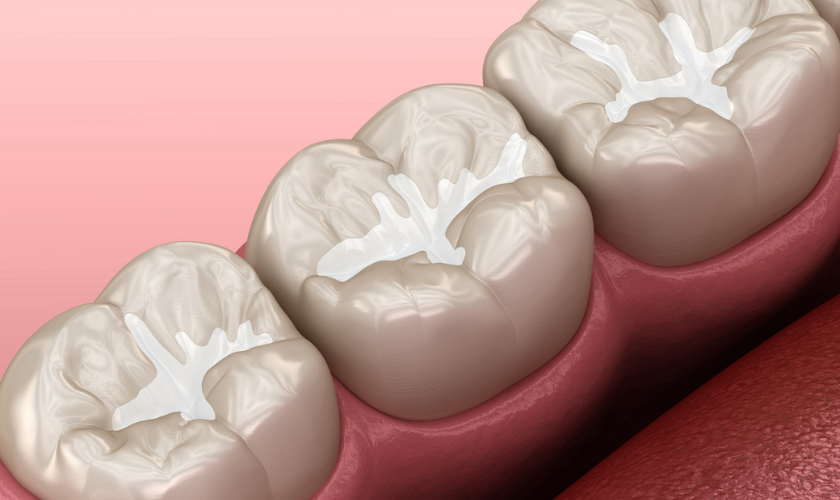(704) 387-3117
AVAILABLE FOR EMERGENCIESShield Your Smile: How Dental Sealants Can Be Your Cavity-Fighting Secret Weapon

Maintaining a healthy smile involves more than just regular brushing and flossing. Despite diligent dental hygiene, cavities can still find their way into your teeth. This is where dental sealants come into play, offering a shield of protection to keep cavities at bay. Let’s dive into the world of dental sealants and explore how they can save your smile.
What Are Dental Sealants?

Dental sealants are thin, plastic coatings applied to the chewing surfaces of the back teeth, primarily the molars and premolars. These areas are particularly susceptible to cavities due to their grooved surfaces, which can trap food particles and bacteria. The sealants form a protective barrier over these grooves, preventing decay-causing elements from settling in.
Why Consider Dental Sealants?
Even with the best oral care routine, certain teeth are more vulnerable to cavities. The chewing surfaces of molars are full of pits and fissures that can be hard to clean thoroughly with a toothbrush. Sealants effectively cover these trouble spots, making it easier to maintain a cavity-free mouth. Here are some compelling reasons to consider dental sealants:
- Enhanced Cavity Protection: Sealants are particularly effective in preventing cavities on molars and premolars. These teeth have deep pits and grooves on their chewing surfaces that act like traps for food particles and plaque. Brushing can need help to reach these areas effectively, leaving them vulnerable to decay. Sealants fill in these grooves, smoothing out the chewing surface and making it easier to clean.
- Long-lasting Defense: Dental sealants are remarkably durable. With proper care, they can last for several years, providing long-term protection against cavities. However, regular checkups with your dentist are essential to ensure the integrity of the sealant and identify any potential issues.
- A Pain-Free Process: Getting dental sealants applied is a quick and painless procedure. Your dentist will clean and dry your teeth before carefully painting a thin layer of sealant onto the chewing surfaces. A special light is then used to harden the sealant, creating a protective barrier.
- Cost-Effective Cavity Prevention: Dental sealants are a cost-effective way to prevent cavities. The cost of getting sealants applied is significantly lower than the cost of treating a cavity, which often involves fillings or crowns.
- Suitable for All Ages: Dental sealants are a great option for both children and adults. Children are especially susceptible to cavities as their enamel is still developing. Sealants can provide crucial protection during this vulnerable time. However, adults can also benefit from sealants, particularly those who have deep grooves in their teeth or are prone to cavities.
The Process of Applying Dental Sealants
Getting dental sealants is a quick and painless process that can be done during a routine dental visit. Here’s a step-by-step guide on what to expect:

- Cleaning the Teeth: Before applying the sealant, the dentist thoroughly cleans the teeth to remove any food particles and plaque. This ensures that the sealant adheres properly to the tooth surface.
- Preparing the Tooth: After cleaning, the dentist applies an acidic gel to the chewing surface of the teeth. This gel roughens the surface, allowing the sealant to bond better with the tooth.
- Applying the Sealant: Once the tooth is prepared, the dentist rinses off the gel and dries the tooth. Then, they paint the sealant onto the tooth enamel, where it bonds directly and hardens. Sometimes, a special curing light is used to help the sealant harden quickly.
- Final Check: After the sealant has hardened, the dentist checks to ensure it covers the tooth surface properly and that your bite is not affected. The whole process takes only a few minutes per tooth.
Who Can Benefit from Dental Sealants?
While dental sealants are often associated with children, they can benefit people of all ages. Here’s a closer look at who might benefit most from this protective treatment:
- Children and Teenagers: Children and teenagers are prime candidates for sealants. Their newly erupted permanent teeth are more vulnerable to cavities. Applying sealants as soon as these teeth come in can provide long-term protection.
- Adults: Adults without cavities or fillings in their molars can also benefit from sealants. If your teeth have deep grooves and fissures, sealants can provide an added layer of defense against decay.
- Individuals with Specific Dental Needs: People with certain conditions, like dry mouth, can be more prone to cavities. Dental sealants can be a valuable preventive measure for these individuals, reducing their risk of tooth decay.
Maintaining Your Dental Sealants
Once you have dental sealants, it’s important to maintain them properly to ensure they last as long as possible. Here are some tips to keep your sealants in top shape:
- Regular Dental Check-Ups: Continue to visit your dentist regularly. They will check the condition of your sealants and make any necessary repairs. This helps maintain their effectiveness and ensures your teeth stay protected.
- Good Oral Hygiene: While sealants provide an extra layer of protection, they are not a substitute for good oral hygiene. Brush your teeth at least twice a day with fluoride toothpaste, and floss daily to remove plaque and food particles.
- Healthy Diet: A diet low in sugar and high in nutritious foods supports overall dental health. Limit sugary snacks and drinks, which can contribute to tooth decay. Drinking plenty of water also helps keep your mouth clean and reduces the risk of cavities.
The Role of Sealants in Overall Dental Health

Dental sealants are just one part of a comprehensive approach to dental health. They work best in conjunction with regular dental care and healthy habits. By protecting the most cavity-prone areas of your teeth, sealants help you maintain a bright and healthy smile.
- Complementary Dental Practices: In addition to sealants, consider fluoride treatments, which can strengthen tooth enamel and make it more resistant to decay. Regular professional cleanings remove plaque and tartar buildup, further protecting your teeth from cavities.
- Education and Awareness: Educating yourself and your family about the importance of dental health can lead to better habits and fewer dental problems. Teach children the value of brushing, flossing, and regular dental visits from a young age.
- Community Programs: Many schools and community health programs offer dental sealant applications for children. These programs aim to reduce the prevalence of cavities and promote better oral health in the community. Participating in such initiatives can be a great way to protect your children’s teeth.
Living Life with Sealed Smiles
Dental sealants offer a practical and effective way to prevent cavities and protect your smile. They are a simple, cost-effective solution that can provide long-term benefits for both children and adults. By incorporating sealants into your dental care routine, along with regular visits to your dentist, you can enjoy a healthier, brighter smile.
If you’re considering dental sealants or want to learn more, consult a professional. For those in North Carolina, a dentist in Charlotte, NC, can provide personalized advice and treatment options tailored to your needs. Don’t let cavities creep in – take proactive steps to safeguard your smile today.